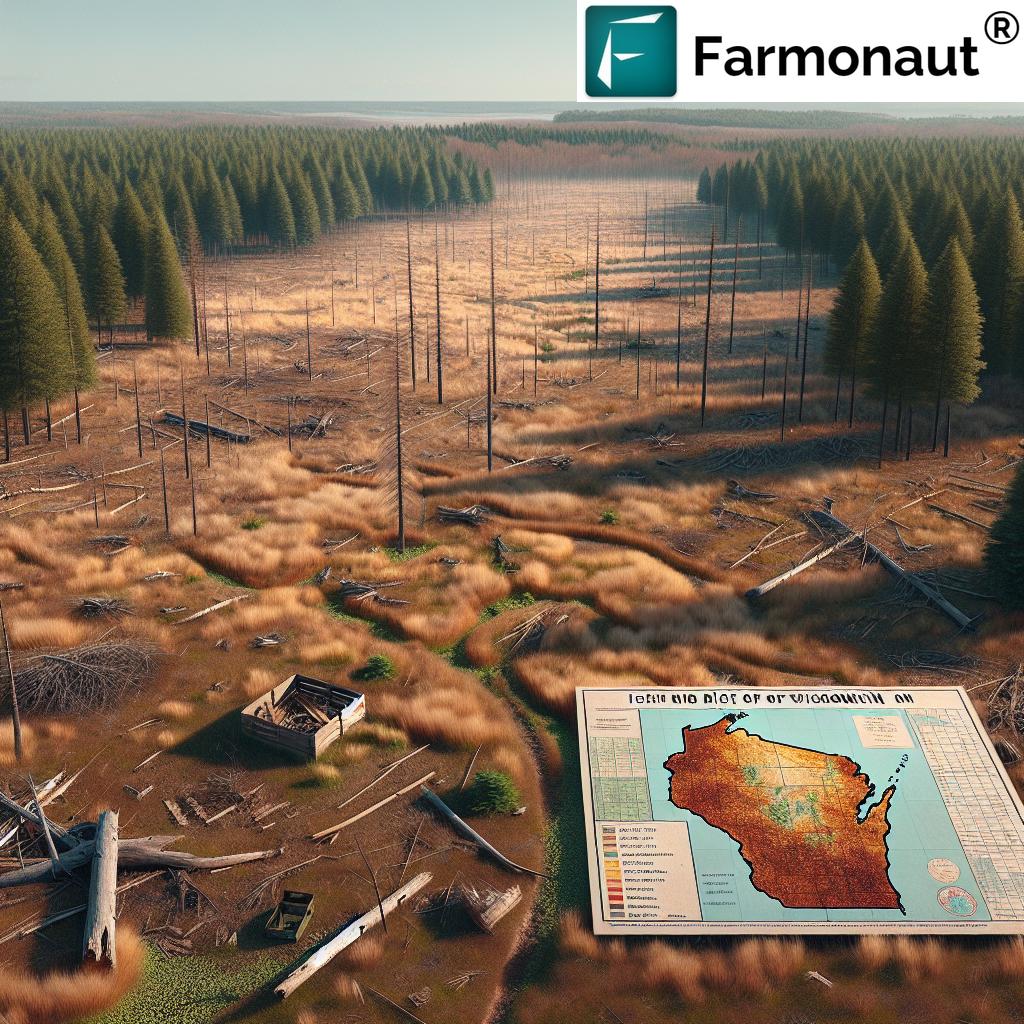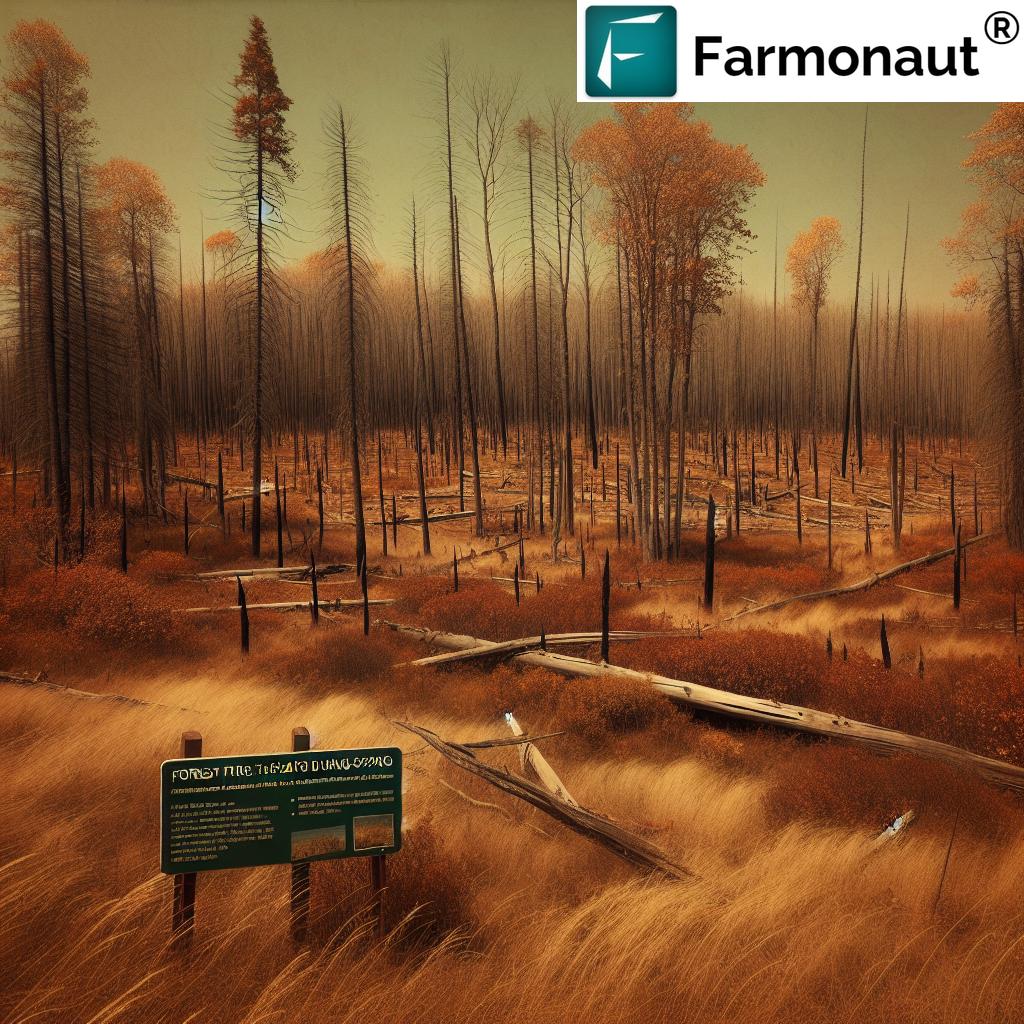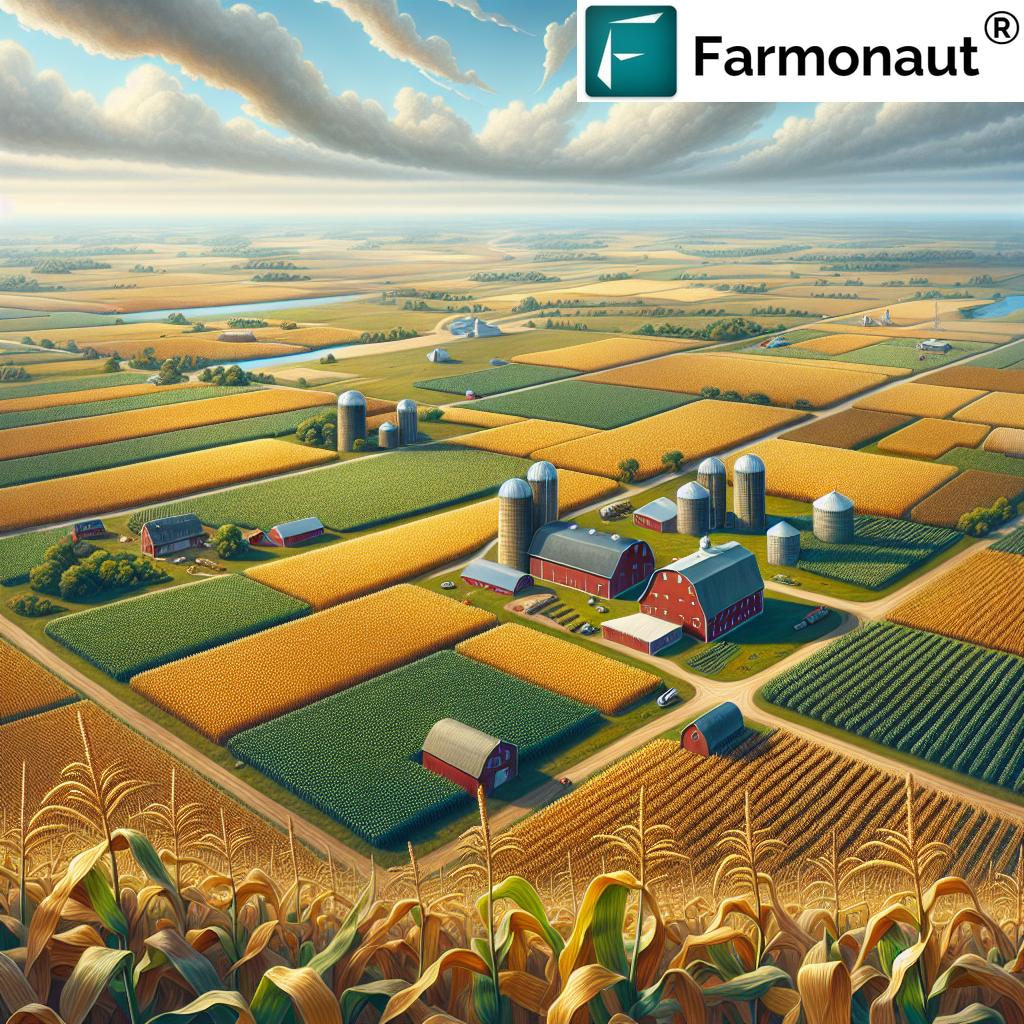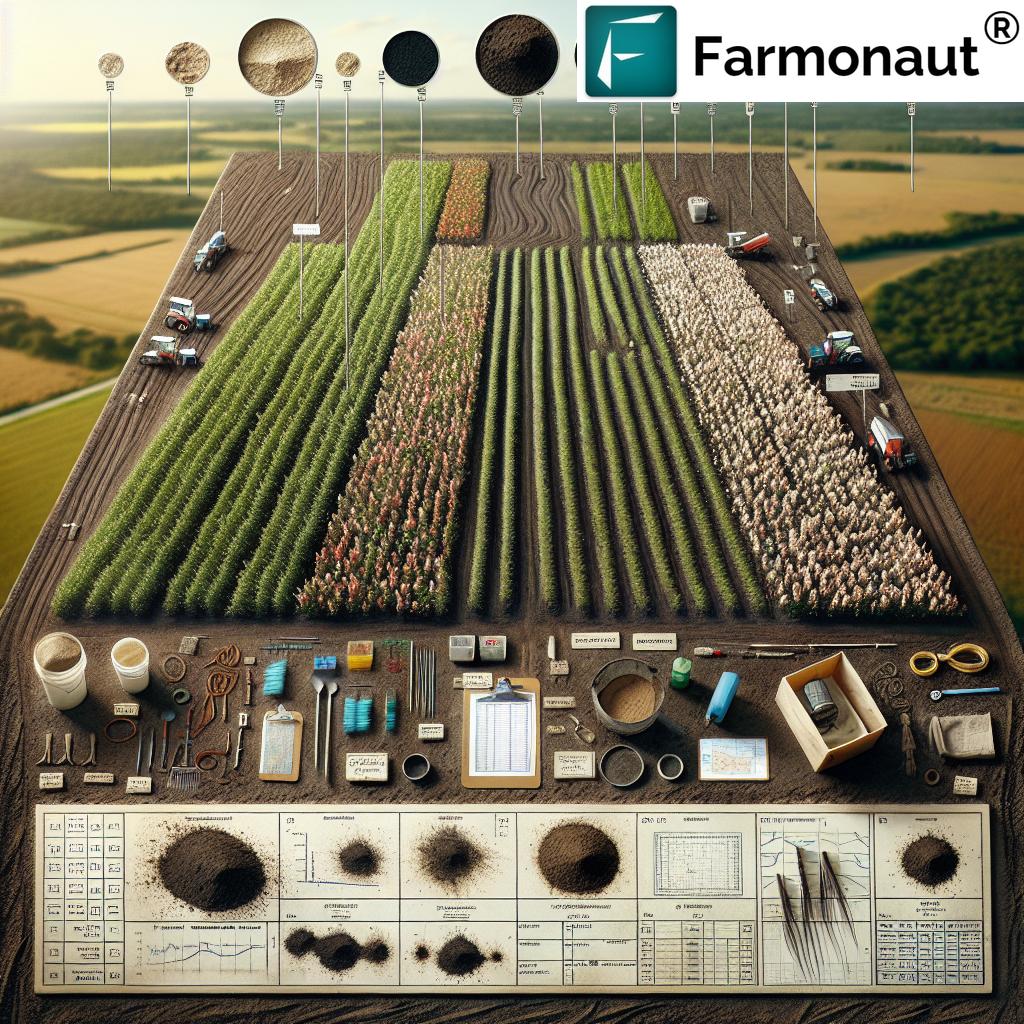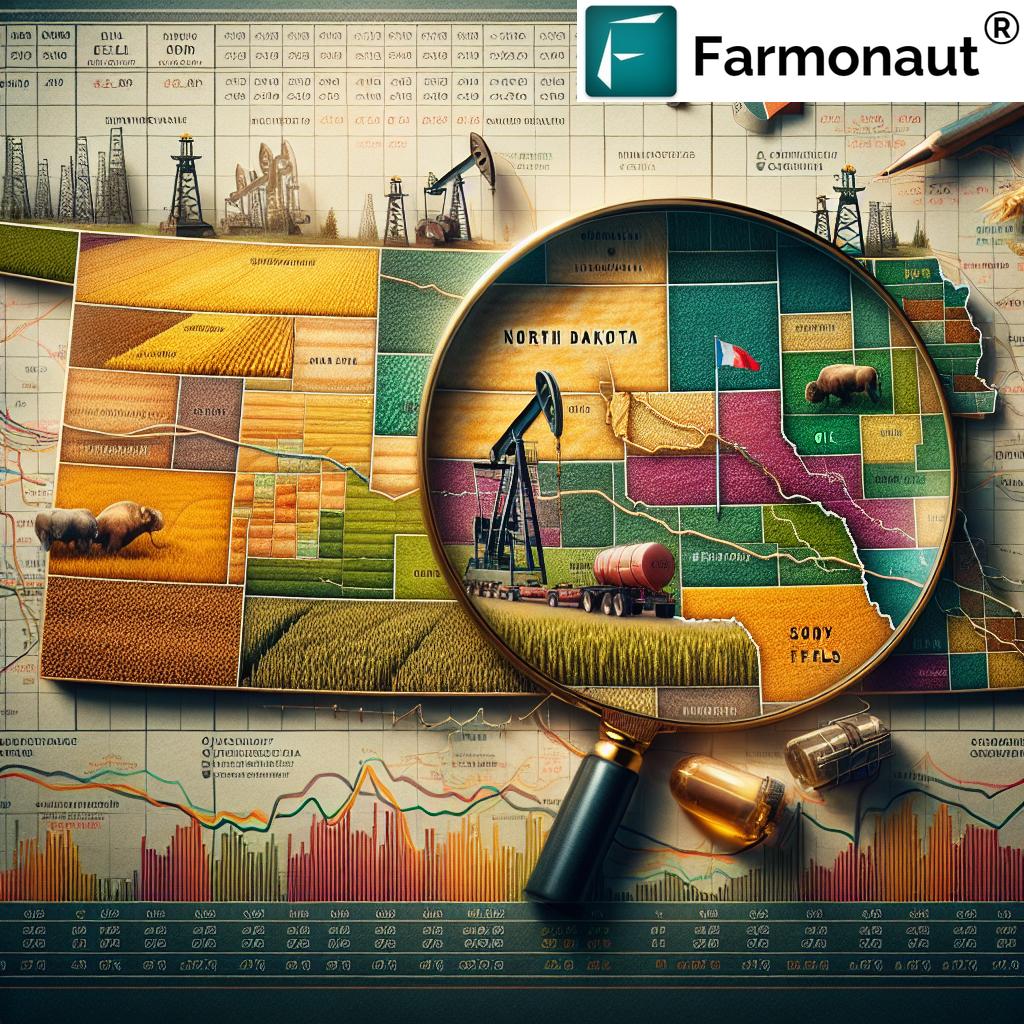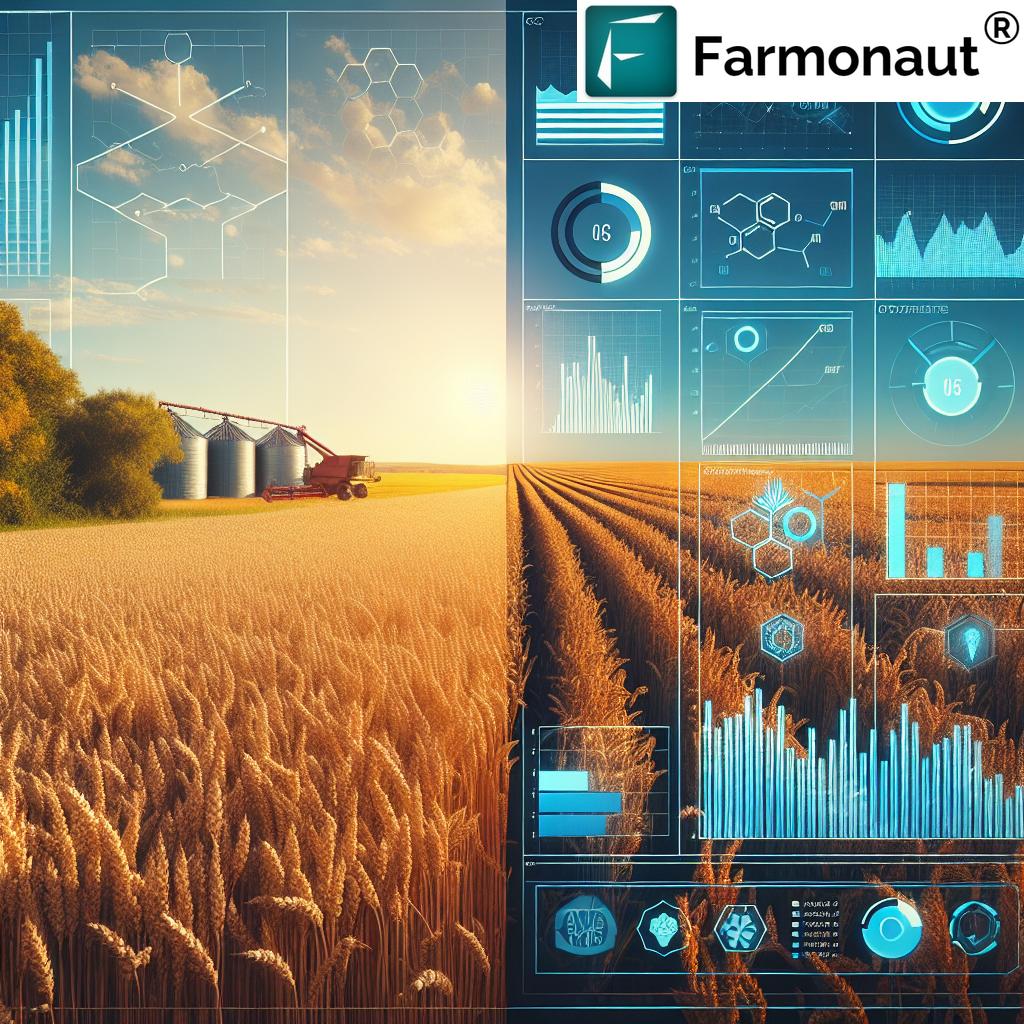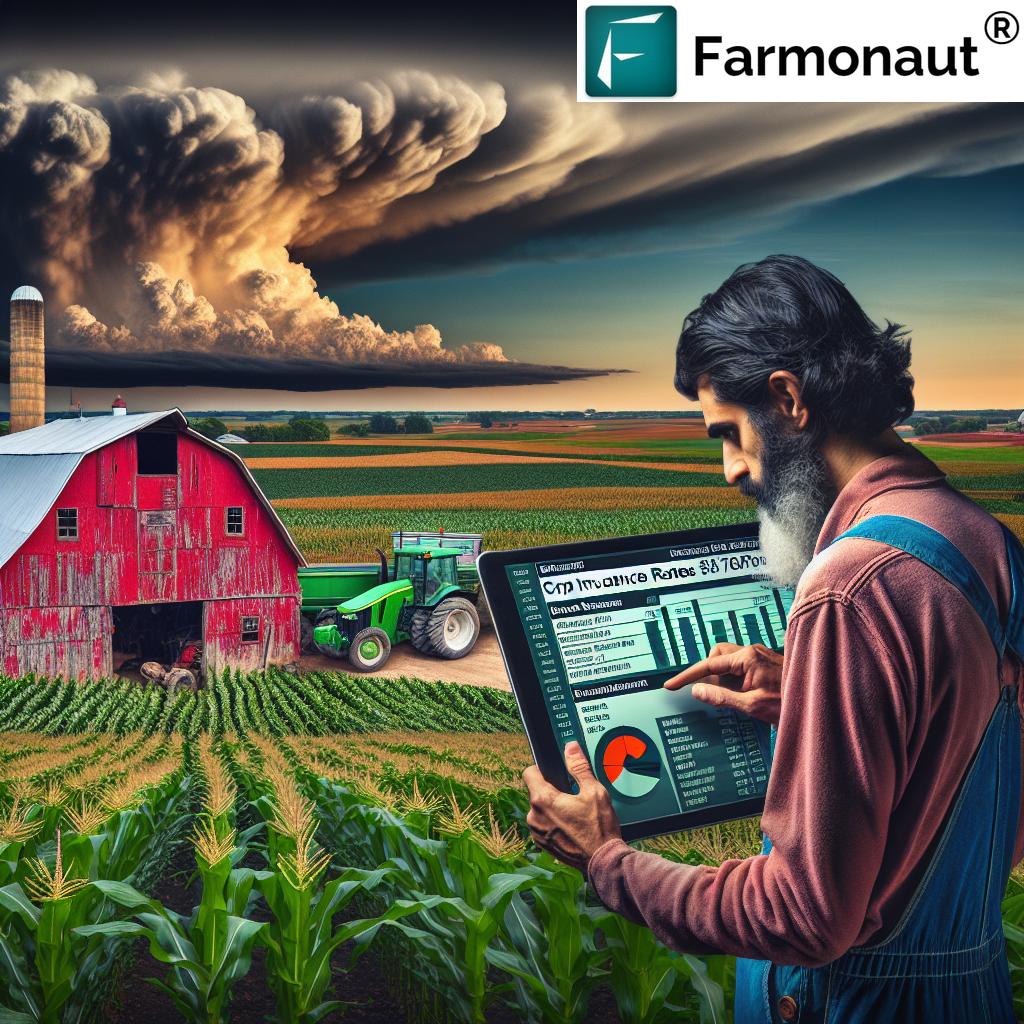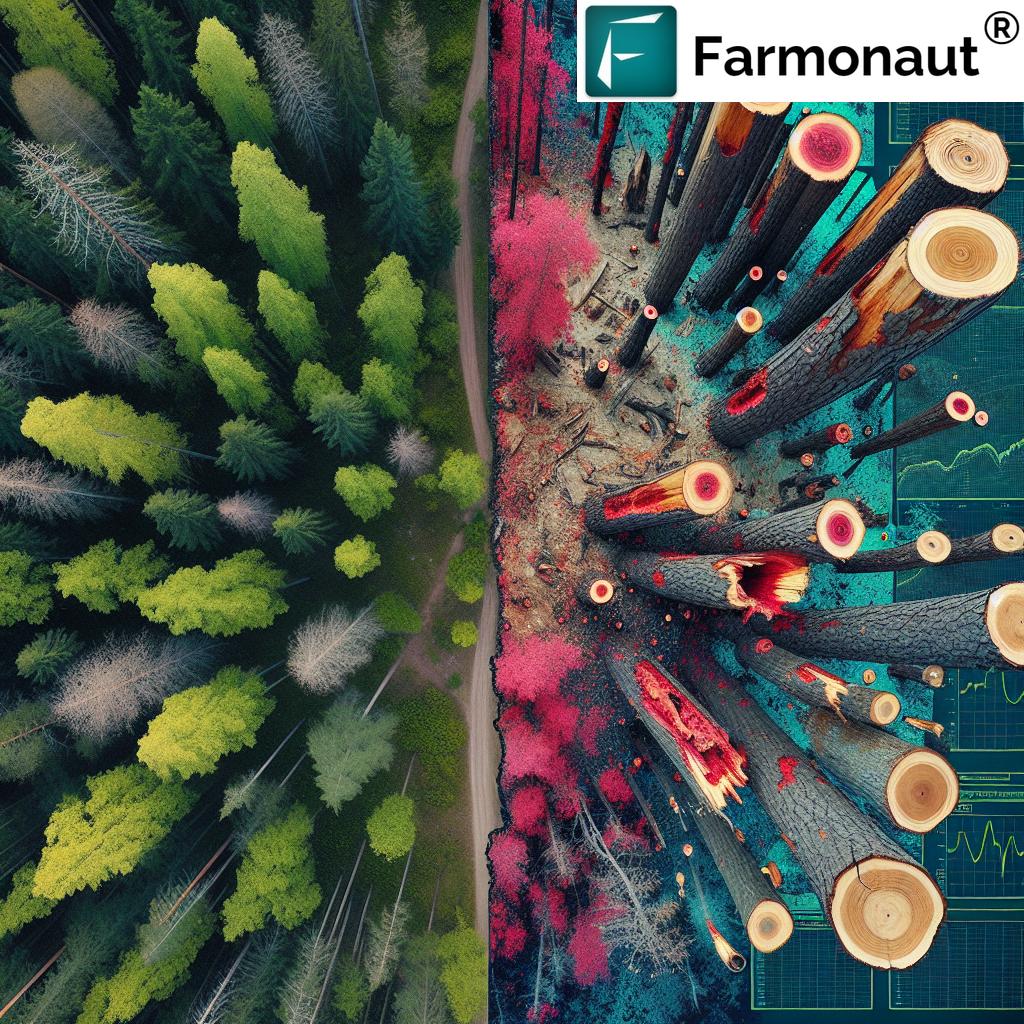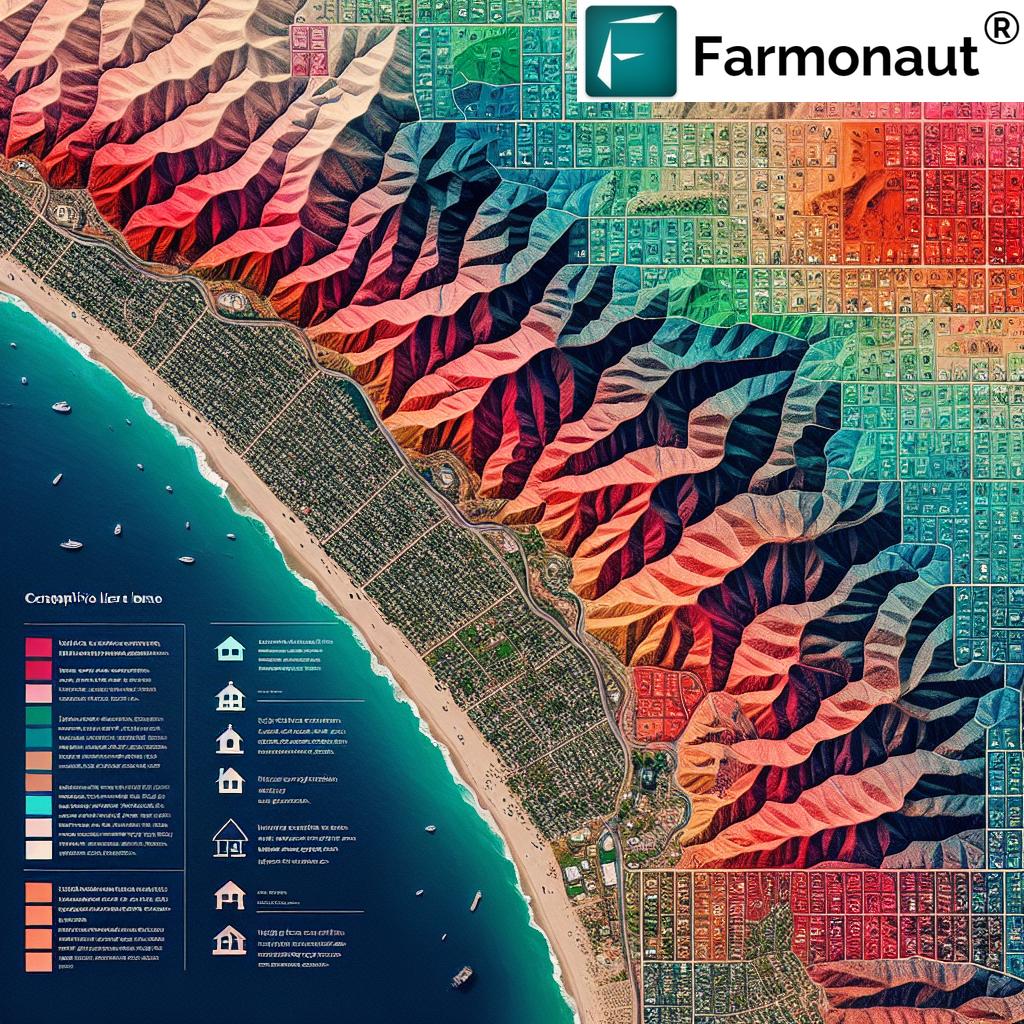Contents
- Understanding Spring Fire Danger in Wisconsin
- Wisconsin Wildfire Risk: 7 Crucial Spring Fire Danger Facts
- Wisconsin Spring Wildfire Risk Factors Comparison Table
- Preventing Wildfires: Safety Tips for High Fire Danger Zones
- How Farmonaut Empowers Sustainable Land Management Amid Fire Risk
- FAQ: Spring Wildfire Risk Wisconsin
- Useful Resources & Farmonaut App Links
“In spring, over 60% of Wisconsin wildfires ignite due to dry vegetation and minimal rainfall.”
Wisconsin Wildfire Risk: 7 Crucial Spring Fire Danger Facts
Every spring, Wisconsin wildfire risk becomes a headline. Our forests, grasslands, and even rural backyards face increased fire danger as dry vegetation, warm temperatures, and sandy soils combine with little rain, creating a recipe for disaster across the state. With more than half of Wisconsin in a “High” fire danger zone in the current season, it’s crucial for everyone—from farmers and foresters to homeowners and municipal responders—to understand wildfire risks and act accordingly.
In this comprehensive guide, we’ll unpack seven critical facts about spring wildfire danger in Wisconsin, why this season is so hazardous, how dnr fire warnings work, and how we can collectively reduce fire risk. We’ll also show how advanced technology—like the Farmonaut platform—can enable smarter decisions at every level, supporting sustainability and environmental stewardship.
Understanding Spring Fire Danger in Wisconsin
We’re all eager for warmer weather as winter recedes, but in Wisconsin, spring is unfortunately synonymous with heightened wildfire risk. Let’s start by understanding why this happens—and why northcentral and northern Wisconsin, with their unique mix of sandy soils, dry forests, and changing vegetation, are at the frontlines during this critical season.
- The annual spring “fire season” in Wisconsin typically begins after snowmelt and before full green-up.
- During this window, the previous year’s dead grass and leaves—labeled “dry vegetation”—are exposed, extremely flammable, and can ignite at the smallest spark.
- Multiple days without rain dry out the soils and ground cover even further, elevating wildfire conditions Wisconsin experts worry about most.
- Combined with sandy soils of the region, which struggle to retain moisture, the wildfire risk can reach very high or even extreme levels quickly.
Why Spring is the Most Dangerous Season for Wildfires in Wisconsin
Amy Penn, a forest specialist with the Wisconsin DNR, explains, “This time of year, if we go more than three or four days without rain, then we’re dry. Now we’re going on a week without rain.” This warning echoes across forestry offices throughout the state: Even a single week without rain can tip vast regions into high fire danger zones.
It’s not just about rainfall, though; let’s break down seven facts everyone in Wisconsin should know about spring wildfire risk.
“Sandy soils cover nearly 40% of Wisconsin’s high-risk wildfire zones, increasing fire spread during dry spring months.”
Wisconsin Wildfire Risk: 7 Crucial Spring Fire Danger Facts
-
1. Dry Vegetation Wildfire Starts: Our Greatest Spring Fire Threat
Every spring, dry vegetation left from the previous fall becomes a potent fuel. When this matter remains dormant after winter and before the woods green-up, it ignites easily.
Key Points:- Over 60% of wildfires in Wisconsin start during spring due to dry grass, leaves, and brush.
- These materials burn rapidly and can spread flames across yards, forests, and fields before responders can act.
- High winds exacerbate the danger by pushing embers further into new areas and hard-to-reach corners of the forest.
Tip: Regularly clear old branches, leaves, and brush near homes and structures, especially before the green-up is noticeable in the woods.
-
2. Sandy Soil Moisture Loss: A Unique Northern Wisconsin Wildfires Risk
The sandy soils throughout northern and northcentral Wisconsin lack the ability to retain moisture. Instead of storing rain for days, sand allows water to seep away quickly.
- Penn notes: “We have really sandy soils here, and up north as well, so sandy soils just don’t hold as much moisture or nutrients.”
- This rapid moisture loss leaves vegetation dry and highly flammable during even brief stretches without rain.
- Sand in soil means that after a rain, conditions can return to “dangerous” in less than three days.
Tip: Farmers and landowners should monitor real-time soil moisture using advanced apps, such as Farmonaut’s crop and soil monitoring tools, for targeted response.
-
3. Low Rainfall and Rapid Dry-Downs Escalate Fire Risk
A week without rain in Wisconsin spring is all it takes for forest fire risks spring to skyrocket. Our frequently sandy soil compounds this problem.
- Even after normal snowmelt, if less than 20 mm of monthly rainfall is recorded in spring, fire risks are “high” across more than half the state, per DNR data.
- Without persistent rainfall, there’s insufficient recharge of soil moisture, and dead vegetation becomes even drier.
- Factor in windy days: strong spring winds can dry out the top layers of forest floor, further priming the land for ignition.
Tip: Pay close attention to DNR fire warnings—they are regularly updated to reflect changing weather and wildfire conditions Wisconsin.
-
4. Dormant Vegetation in Forests Is Slow to “Green Up” in Spring
While yards and urban landscaping may green up after the first warm spell, forests behave differently. Understory grass and forest floor cover remain brown and dry.
- Penn says: “We’re seeing a lot of green-up in yards, but in the woods, that grass is still brown and dry.”
- This dormant vegetation acts as kindling. A single ember from a fire pit or discarded cigarette can start a wildfire in these conditions, especially in rural county woods.
Tip: If you live adjacent to woodlands, don’t rely on grass in your yard as an indicator—assume forest floors are still flammable into May.
-
5. Debris Burning Restrictions: The Number One Preventable Cause
In spring, debris burning is responsible for the largest share of wildfires statewide. This is why the DNR frequently issues burn bans or prohibits open burning in high-risk areas.
- “Most debris burning is suspended in the state, so our number one cause is debris burning,” clarifies Penn.
- Two out of every three spring wildfires start when someone burns leaves or brush on a windy, dry day.
- In just the last week, the DNR responded to nearly 100 new fire incidents caused by open burning during dangerous conditions.
Tip: Always confirm local debris burning restrictions before lighting any fire outdoors, especially in the spring.
-
6. Extreme Wildfire Conditions Can Span Counties in Days
With the right (or wrong) combination of weather variables, high fire danger expands quickly across northern and northcentral Wisconsin.
- It only takes several windy, warm days with no rain for a “moderate” county to jump to “very high” or “extreme” on the DNR’s fire danger scale.
- Fires then move much faster in these zones, endangering people, wildlife, infrastructure, and critical forest resources.
Tip: Stay alert for dnr fire warnings and encourage your community to implement fire safety protocols ASAP when local risk levels escalate.
-
7. Human Awareness and Community Support: Critical to Mitigation
According to Penn, “When conditions are this difficult, we definitely look to the public to help us out and do their part.”
- The majority of spring wildfires are preventable with public vigilance and fast local reporting of suspicious smoke or unauthorized burning.
- DNR and county fire response resources are stretched during peak season; help by reporting fires—don’t assume someone else already has.
Tip: Share DNR alerts, monitor local social media, and stay in touch with your neighbors about safe outdoor burning and fire safety!
Wisconsin Spring Wildfire Risk Factors Comparison Table
| Risk Factor | Estimated Impact on Fire Risk | Typical Spring Value/Measurement | Tips to Reduce Risk |
|---|---|---|---|
| Dry vegetation (dead grass, leaves) | High | 60–80% of ground cover dry before green-up (April-May) | Clear dead brush; delay all open flames |
| Sandy soils (moisture retention loss) | High | Covers 35–40% of wildfire-prone counties; soil moisture <15% | Monitor soil with tech platforms; add mulch to retain moisture |
| Low rainfall / precipitation | High | Below 25mm/month in key spring months triggers fire warnings | Advocate for county water conservation; suspend burns |
| Winds (spring gusts) | Medium–High | Frequent 15–30 mph gusts April–May | Never burn on windy days; secure fire pits |
| Dormant forest floor | High | 70–90% of woodland understory is brown until mid-spring | Delay any burning until visible green-up; monitor undergrowth |
| Debris burning activities | High | Cause of 60–70% of spring wildfires, especially on weekends | Respect burn bans and restrictions; compost instead |
| Human awareness/public intervention | Very High | Most wildfires could be avoided with improved reporting & education | Share DNR info; link with local fire plans |
Preventing Wildfires: Safety Tips for High Fire Danger Zones
With such a high concentration of northern Wisconsin wildfires each spring, what practical steps can we all take? The DNR’s recent warning highlights: “We’re going to need extra help from people to help mitigate the risk.” Let’s break down how every landowner, resident, and agricultural worker can participate in safeguarding our forests, farms, and communities from spring fire danger.
-
Follow DNR fire warnings and local burn bans:
- Check the current fire danger map each morning.
- Burn bans can update daily in high-risk zones.
-
Prepare your home and property:
- Remove dead vegetation, leaves, and brush from within 30 feet of your house, barns, and outbuildings.
- Keep grass trimmed short, and use gravel, pavers, or bare soil instead of wood mulch near foundations.
- Store firewood and burnable debris far from building walls.
-
Actively communicate with neighbors and community members:
- If you see smoke or flames, call 911 immediately—don’t assume someone else did.
- Help elderly or disabled neighbors keep their properties fire-safe.
-
Limit equipment operation on high-risk, windy, or dry days:
- Avoid using chainsaws, mowers, or welders outdoors when fire danger is high. Hot engines and sparks can easily start a grass or forest fire.
-
Embrace sustainable land management:
- Adopt carbon footprint reduction practices; see Farmonaut’s Carbon Footprinting solution for real-time emissions and sustainability insights.
- Use satellite–based tools for crop and forest plantation monitoring and get early detection of drought/wildfire threat indicators.
-
Fully observe debris burning restrictions:
- Even a small, “legal” debris fire can escape quickly in the wrong conditions. Compost leaves and brush or wait for safer months.
By staying proactive and using the latest digital and community tools, we can significantly reduce wildfire disasters during Wisconsin’s most perilous season.
How Farmonaut Empowers Sustainable Land Management Amid Fire Risk
Risk reduction isn’t only about manual tasks. Precision technology can play a vital role for everyone—from large agribusinesses to individual farmers and local governments. That’s where our solutions at Farmonaut come in.
Using Farmonaut for Real-Time Crop & Forest Fire Risk Monitoring
-
Satellite-Based Crop and Vegetation Monitoring:
Our satellite tools allow users to assess crop health, soil moisture, and vegetation dryness in real-time. By detecting sections of a field or forest that are particularly at risk of drying out, landowners can deploy water, alter management, or alert authorities before disaster strikes. Learn more & try the web/app! -
AI-driven Risk Forecasting:
The Jeevn AI Advisory analyzes state, regional, and local wildfire risk conditions to suggest the best mitigation tactics at every stage—be it crop greening, irrigation scheduling, or adjusting field operations. -
Fleet and Resource Management:
For landowners and businesses operating over a wide area, Farmonaut’s Fleet Management solution helps efficiently coordinate fire prevention maintenance, log forest observations, and distribute firefighting equipment—all with the benefit of real-time satellite tracking. -
Blockchain-Based Product Traceability:
By using Farmonaut’s traceability platform, companies and cooperatives ensure their agricultural and forest-sourced products come from certified, safe, and responsibly managed lands, promoting transparency and trust to customers. -
API & Integration:
Developers, agricultural businesses, and research groups can harness Farmonaut’s API—see full developer documentation here—for advanced fire risk alerting, weather monitoring, and integration into local emergency response systems.
Affordable, Scalable, and Accessible: Farmonaut Subscriptions
From single fields to vast landscapes, Farmonaut’s subscription options deliver advanced crop and wildfire risk analytics at low cost. Explore plan options for farmers, agribusinesses, and government institutions below.
FAQ: Spring Wildfire Risk Wisconsin
Why is spring the wildest wildfire season in Wisconsin?
Spring presents the most perilous fire conditions because snowmelt exposes dormant, dead vegetation before new growth can green and moisten the landscape. Combined with sandy soils and infrequent rainfall, flammable fuel abounds and is easy to ignite.
Which areas or counties in Wisconsin are most at risk?
Wisconsin’s northcentral and northern counties—where sandy soils and large tracts of forest dominate—are traditionally most at risk, but high fire danger can extend statewide after dry, windy weeks.
What is the number one cause of wildfires during spring?
Debris burning is the top cause. Most spring wildfires start when property owners attempt to burn brush, grass, or trash under dangerous conditions—often in violation of burn bans.
How can technology help reduce wildfire risk on my land?
Tech solutions—such as Farmonaut’s crop/soil/fire risk monitoring via satellite—offer real-time feedback about vegetation dryness, soil moisture loss, and hotspots, so landowners can act quickly and efficiently.
Where can I check current Wisconsin fire danger and burning restrictions?
Visit the Wisconsin DNR Fire Report page for up-to-the-minute details on fire risk, active wildfires, and county-specific debris burning restrictions.
Useful Resources & Farmonaut App Links
- Get started with Farmonaut’s precision monitoring: Web & App Portal
- Explore real-time Carbon Footprinting: Farmonaut Carbon Tracking
- Product Traceability for Responsible Sourcing: Farmonaut Traceability
- Crop Plantation and Forest Advisory: Satellite-based Plantation Advisory
- Agro-admin app for large-scale farm management: Farmonaut Large-scale Management
In summary: Spring fire danger in Wisconsin escalates fast due to a perfect storm of dry vegetation wildfire risk, sandy soil moisture loss, and unpredictable rainfall and winds. The key to protecting our forests, farms, and communities is a blend of public vigilance, sustainable fire management practices, and data-driven tools. By integrating tech platforms like Farmonaut into our wildfire prevention strategies—and staying informed with DNR fire warnings—we take proactive steps to face the challenge of wildfire season together.
Learn. Prepare. Protect. Together, we can keep Wisconsin’s wild places and working lands safe and resilient all spring—and for many years to come.


